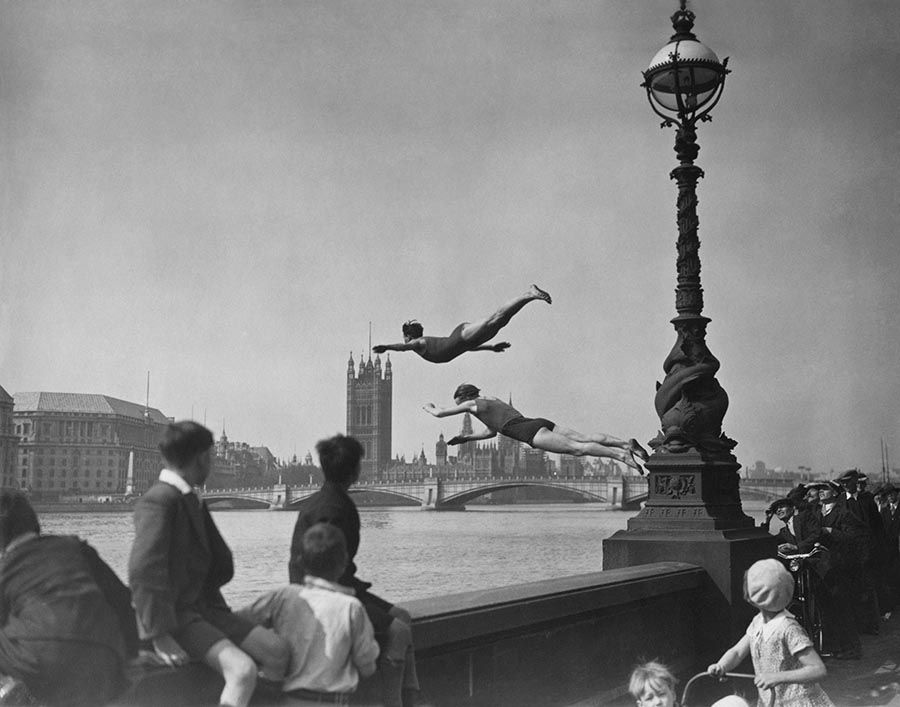City Diaries: London
Learn more about the London digital photographs in this month's Exposure collection.

Whether you are an avid collector, an art enthusiast, or simply someone who values the beauty of the past, owning a digital collectible from the Candy x Getty Images collection is an invitation to embrace the extraordinary and become a part of a vibrant community that celebrates the power of art and storytelling.
This journey takes us to London, a layered metropolis that is both timeless and constantly reinventing itself. From its skylines to the street scenes, London's eclectic features tell the story of a city that has shaped the world.
Each of the four photographs below, taken from the City Diaries Collection, provide an intimate glimpse of this global center through the ages.
Fox: Platform Milking (1926)
As early as the 17th century, London had established markets specifically dedicated to the trade of milk and dairy products. As limited access to fresh milk became a challenge during London’s rapid urbanization in the early-mid 1900s, dairy farmers found innovative ways to meet the city's demand.

Pictured: In the early 20th century, milk was commonly transported by rail from rural areas to the cities across the UK. Farmers would bring their cows to the station, where they would be milked on a raised platform and the milk would then be loaded onto the train for transport to London's dairy markets. Bringing cows directly to the heart of London allowed for the immediate availability of farm-fresh milk, bypassing the challenges of transportation and preserving its quality. For many Londoners, fresh milk was an essential part of their diet, and the arrival of these "milk trains" was eagerly anticipated.
H F Davis: Thames Divers (1934)
For centuries, the Thames has been integral to London's identity and growth, serving as a vital trade route and source of livelihood. The city flows alongside iconic landmarks and has long served as a constant backdrop to the ebb and flow of daily life. On top of that, the Thames was also a source of inspiration for city kids eager to claim their own slice of adventure within the heart of the capital.

Pictured: During London’s sweltering summers, London youth would sometimes seek respite from the heat in the Thames’ cool waters. Public swimming pools were rare at the time, and while air conditioning was invented at the dawn of the 20th century, it was mainly reserved for wealthy individuals and large commercial establishments prior to the post-WWII economic boom. As a result, some city residents would turn to the Thames as a convenient way to cool off, climbing to precarious heights to pull off splashy stunts – to the admiration and occasional consternation of nearby spectators.
Kurt Hutton: Commissionaire's Dog (1938)
Piccadilly Circus has long been synonymous with the glamor, excitement, and social vibrancy that continues to define it today. During the late 19th and early 20th centuries, the district greatly benefited from the introduction of electric lighting, the growth of commercial entertainment venues, and the expansion of luxury shops and hotels.

Pictured: Hotel commissionaires were a daily fixture of the streets of Piccadilly Circus. Dressed impeccably in a distinctive uniform, the commissionaire was a familiar sight and played an integral role in shaping London's vibrant social scene. With their impeccable manners and expert knowledge of the area, they provided a sense of assurance to residents and visitors alike, giving warm welcomes and a wealth of information about the city's many wonders.
Haywood Magee: Football In The Street (1950)
Football has long created a sense of community and camaraderie in London, bringing people together across social and economic divides. And while the term “soccer” is now commonly associated with American sports fans, the name actually originated in England in the late 19th century in order to distinguish the sport from ruby football, which was also widely played at the time.

Pictured: Young football enthusiasts transforming the urban landscape into their very own pitch. Fueled by a shared passion for the beautiful game, these youths found ways to play football amidst the bustling streets and limited open spaces of their neighborhoods. With makeshift goals marked by jackets or discarded crates, their youthful imaginations soared as they dribbled, passed, and scored through the cobbled streets of London.
Own a piece of England’s timeless capital, distilled into four iconic images. Check out our drop page and the marketplace — and claim your free to mint image if you haven’t already.

